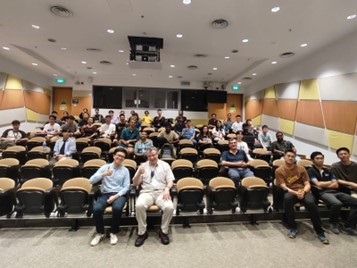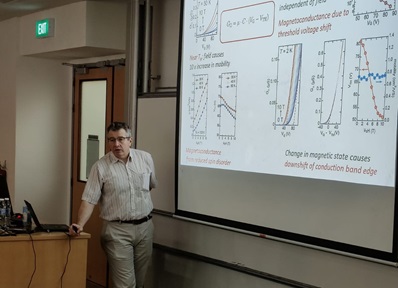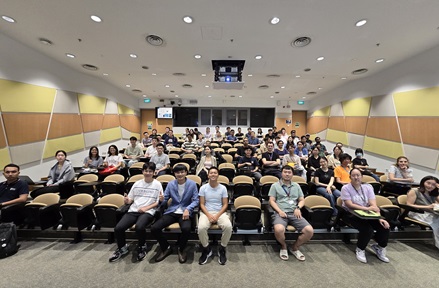A New Trajectory for Space Photovoltaics with Halide Perovskites: Opportunities and Challenges by Asst Prof Jae-Sung Yun
IAS@NTU STEM Graduate Colloquium
The IAS@NTU STEM Graduate Colloquium, organised in collaboration with the Graduate Students’ Club from the School of Physical and Mathematical Sciences (SPMS) featured an illuminating talk, A New Trajectory for Space Photovoltaics with Halide Perovskites: Opportunities and Challenges by Asst Prof Jae-Sung Yun from the University of Surrey.
Prof Yun’s research focuses on the development of emerging solar cells and the nanoscale functional imaging of thin film solar cells. He investigates the factors that limit device performance by correlating nanostructures with their electrical, chemical, and optoelectronic properties. Recently, he has turned his attention to adapting halide perovskite devices for space environments, where extreme temperature fluctuations, high-energy radiation, and vacuum conditions present unique materials challenges. His current research aims to develop high-efficiency, lightweight photovoltaic technologies for space-based solar power and satellite platforms operating in low-Earth orbit and beyond.

Prof Yun began the colloquium by presenting recent advances in halide perovskite (HP) solar cells for space-based energy applications, highlighting their potential as low-cost, high-efficiency alternatives to conventional photovoltaics. He highlighted that while triple-junction solar cells remain the standard for space missions, they suffer from high cost, limited defect tolerance, and irreversible radiation damage. In contrast, halide perovskites offer defect and radiative recombination tolerance, enabled by the formation of defect states close to the band edges. However, long-term stability remains an open challenge.

Prof Yun shared how halide perovskites withstand space radiation and extreme temperature swings.
Prof Yun then shared results demonstrating that HP devices can maintain operational performance for over 10 years in space conditions with ~20% performance loss without a cover glass, with radiation-induced degradation largely reversible. Proton irradiation tests using low-fluence beams showed initial performance loss, but experiments revealed full recovery within 40 days, thus pointing to a self-healing mechanism not observed in silicon-based technologies. Temperature stability, a critical concern in low Earth orbit (LEO) where materials undergo rapid swings from –80 °C to +80 °C, was also addressed. Dr Yun’s thermal shock tests subjected HP devices to over 100 cycles at 16 °C per minute, with no significant structural failure, suggesting their resilience under orbital thermal stress. These findings position halide perovskites as promising candidates for future lightweight, radiation-tolerant solar platforms in space.

Insightful Q&A session with valuable questions and takeaways on space solar tech challenges and future possibilities.
The remainder of the talk shifted to an engaging Q&A segment, sparking an insightful conversation with the attendees on exploring the practical challenges and opportunities of deploying halide perovskite solar cells in space. Discussions on the scalability of HP device fabrication for large-scale satellite constellations ensued, to which Prof Yun acknowledged current manufacturing limitations and some promising solutions. Concerns of long-term degradation mechanisms beyond radiation and temperature effects were raised, leading to a discussion on the role of various strategies and protective barriers in the vacuum of space.
The vibrant exchange underscored the interdisciplinary relevance of Prof Yun’s research, leaving attendees inspired by the possibilities that lie ahead for halide perovskite photovoltaics both on and off the planet.
Written by: Chirantan Mitra | NTU School of Physical and Mathematical Sciences Graduate Students' Club
“I enjoyed the sharing of recent updates about the current new generation solar cell technologies” – Choong Li Yan Anthony (PhD student, MSE)
“This was an interesting topic and knowledge outside my field” – Zhou Ying (PhD student, MAE)
“I particularly enjoyed the real-world application in space” – Wei Sicheng (PhD student, SPMS)







